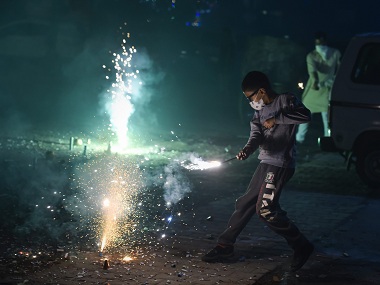After making slow improvements over the first week of November, air quality in Delhi and adjoining areas reached hazardous levels once again on Wednesday and Thursday because of widespread bursting of crackers over the Diwali festival, coupled with industrial and vehicular emissions. Following Diwali, a thick haze had enveloped Delhi-NCR. It had reached “hazardous” levels on Thursday with AQI recorded at 999 around India Gate area. Reuters captured the changing air quality in the national capital from 29 October to 8 November, through a series of photographs from a fixed camera.
A window into Delhi’s deadly pollution: Reuters set up a camera on top of our bureau in the Indian capital, capturing hundreds of images over October-November and presenting a bleak picture of conditions in the city of 20 million https://t.co/unLc3DoD4y pic.twitter.com/50sld8VOm1
— Reuters Asia (@ReutersAsia) November 9, 2018
The camera, situated on the roof of the Parsvnath Capital Towers building, at the heart of the national capital, was designed to take a series of hourly images. These images were then combined with corresponding data on PM 2.5 particulate matter in the air from nearly monitoring stations, to create a timelapse graphic showing the severity of the situation. PM2.5 is considered a highly damaging particulate matter especially since it can lodge deep in the lungs and cause major health problems. The WHO recommends a daily mean air quality guideline of 25 micrograms per cubic metre of PM2.5. It says any reading above 250 for a 24-hour period is an air pollution emergency, Reuters said. The graphic also shows how air quality in the national capital can change rapidly. Air quality remans severe on Saturday morning On Saturday, air quality in the city and adjoining areas continued to remain “severe” in Anand Vihar, Ashok Vihar, Bawana, Burari and Dwarka, while it was a notch below at “very poor” in Major Dhyan Chand National Stadium, ITO, Jawaharlal Nehru Stadium and Lodhi colony, IANS said. Visibility dropped to 700 metres on Saturday morning as pollution levels remained severe at many places in the city besides a fog envelope, the Met said. The minimum temperature was recorded at 12 degrees Celsius, two notches below the average, while the maximum was likely to hover around 30 degrees Celsius. “The sky will be clear with fog or mist in the early part of the day. While there will be smog or haze later on,” an India Meteorological Department (IMD) official said.


)

)
)
)
)
)
)
)
)



